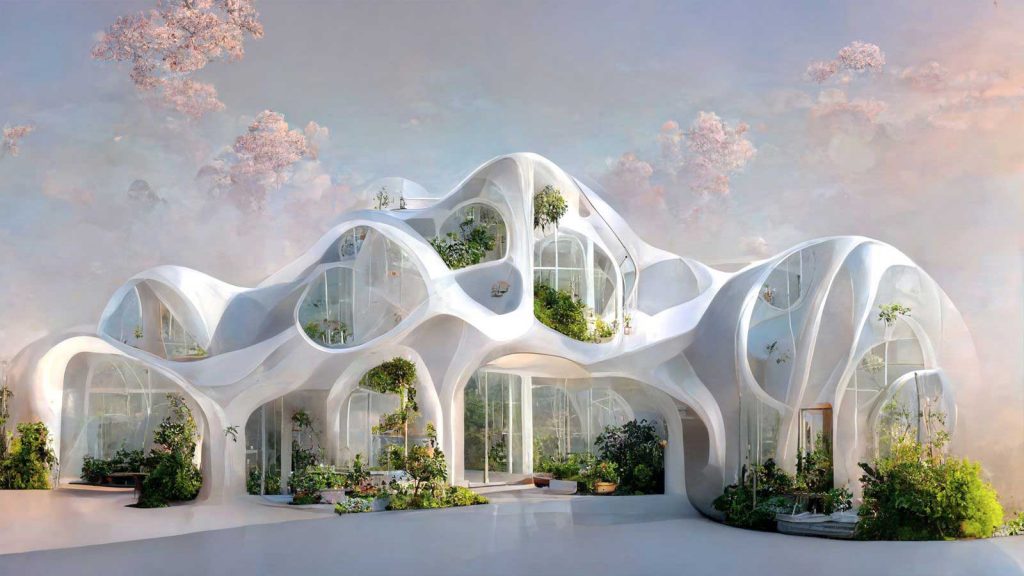The AI art generator Midjourney is the favored tool in architecture. And designers are using it to conjure up their wildest dreams.
Imagine a library made from yarn. Or skyscrapers in the style of Salvador Dalí. Or simply your ideal home, as realistic or fantastical as you like. All it takes is the prompt “/imagine” followed by a few words of description — say, “a neofuturist villa made of concrete and bamboo” — in order for artificial intelligence-powered art generator Midjourney to summon images of whatever you ask for, in under a minute.
Bloomberg – January 31, 2023
Several developers rolled out text-to-image AI programs to the public last year, including Dall-E and Stable Diffusion. These tools, which were trained on vast amounts of online images — leading to copyright lawsuits — became major hits with general audiences, who put these programs through their paces. Amateur designers are using AI assistants to realize fan art, stock “photos,” and a painting that won an arts competition.
Midjourney — a tool by an independent research lab of the same name founded by entrepreneur David Holz — quickly emerged as the architect’s favorite artificial intern. Architects all over the world have seized upon this tool to conjure their wildest dreams. Some are even starting to test out ways to use it in their real-life work. On Instagram, where many architects share their AI-fueled imagery, more than 72,000 posts have been tagged #midjourneyarchitecture.
“Midjourney is the very creative, artistic one that will essentially give you a visual aesthetic that is superior to all the rest,” says Tim Fu, an architectural designer from Zaha Hadid Architects’ computational research group (ZHACODE) in London.
Source: Tim Fu
In workshops that he teaches through Parametric Architecture Academy, Fu lays out the basics of Midjourney architecture. First, students learn how to craft a strong prompt word by word, and build a personal library of terms to draw from. Next, his students learn to refine images through iteration: Midjourney responds to each prompt with four images, but they can choose the ones they like best and use them to iterate brand new images, and so on for as many rounds as they like.
As a teaching example, Fu uses his “Villa Surrealiste.” This is his prompt: “rolling hills contemporary house luxury property pool cubist parametric timber structure modernist villa white renzopiano photography whitegranite futuristic cozy warm lights.” He then went through more than a hundred iterations, pushing the design in different directions before settling on a final image.
“Different students using the same technology can get such different results,” Fu says. “To me, that goes to show that this is a tool that can aid us but still requires the control and the artistry of the person using it.”
Exploring the surreal frontier
Some architects have been using Midjourney to delve deep into surreal worlds, freeing themselves for a moment from practical considerations.
Source: Hassan Raqab
Hassan Ragab, a computational designer working in architecture in Los Angeles, has used all sorts of incongruous materials in his Midjourney buildings, including feathers and cotton candy. Now he’s using the AI tool to create homages to his hometown of Alexandria, Egypt. For his series “The City is a Tram,” Ragab melds the city’s yellow trams with art nouveau architecture from its downtown.
“I used to take the tram everywhere as a child,” Ragab says. “This image is like a dream, mixing my memories together to come up with something new.”
However, when Ragab tried to create designs incorporating elements of Islamic architecture, he discovered the limits of current AI art generators.
“When I work with non-Western architecture, it’s hard for me to get good images because these tools seem to lack a deep understanding of these styles,” he says. He is not alone in this critique: users from different parts of the world have pointed out that AI art generators seem to better understand architecture from the West than from other regions, likely reflecting gaps in the image banks that the tools are trained on.
